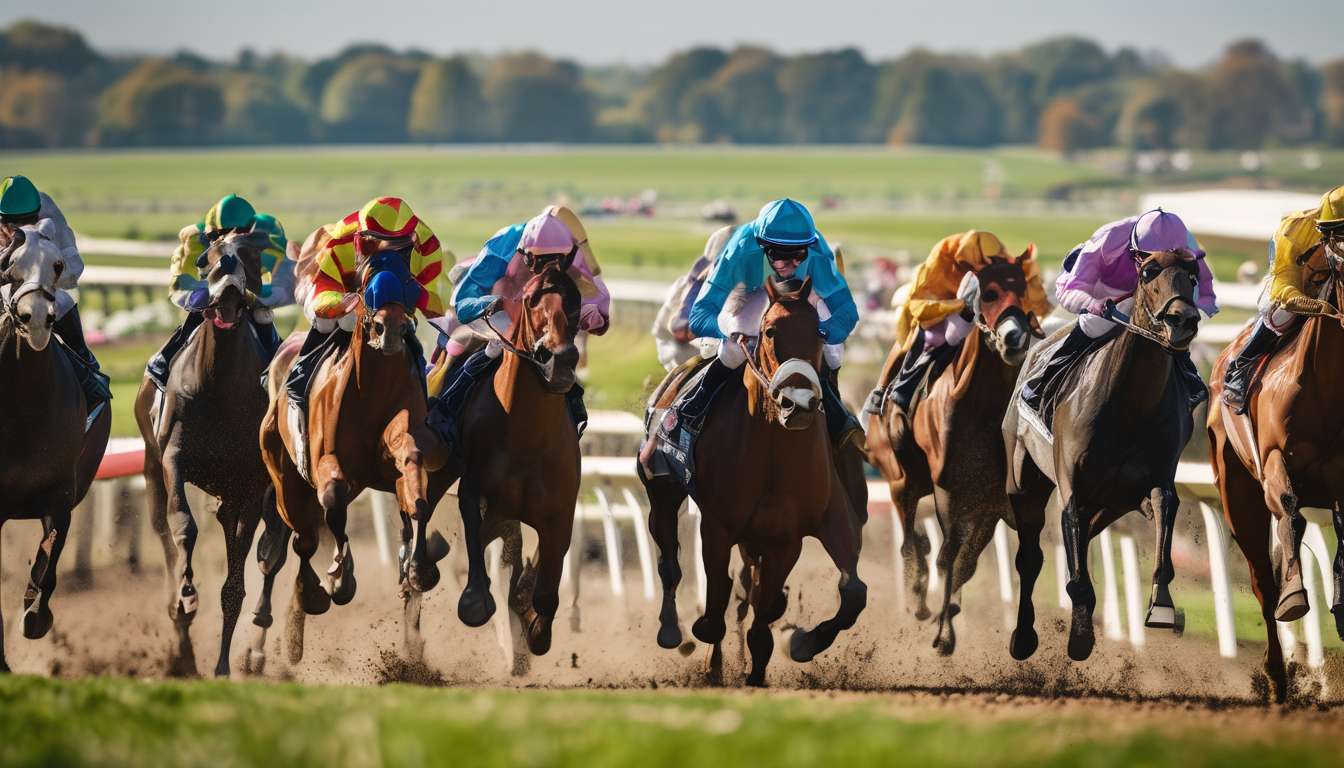In the thrilling world of horse racing, we find ourselves captivated by the challenge of predicting the outcome of each race. As analysts, we delve into the intricate realm of racing handicapping, where data, intuition, and experience converge to guide our predictions.
Together, we explore the popular methods that have become cornerstones in our analytical toolkit, allowing us to evaluate horses and races with a sharp eye. From speed figures and pace analysis to class considerations and form cycles, we employ an array of techniques to decipher the complexities of the sport.
Our goal is to uncover the hidden potential within each contender, relying on both time-tested strategies and innovative approaches. As we navigate the exhilarating highs and inevitable lows of this pursuit, we remain committed to sharing our insights with fellow enthusiasts and newcomers alike, fostering a deeper appreciation for the art and science of racing handicapping.
8 Popular Racing Handicapping Methods
In the world of horse racing, we often rely on eight popular handicapping methods to help us predict a race’s outcome with greater accuracy. These methods are more than just analytical tools; they’re part of what brings us together as a community, united in our love for the sport and the thrill of the track.
Among these methods, Speed Figures, Track Bias, and Trainer Stats are crucial in shaping our predictions.
-
Speed Figures:
- Allow us to assess a horse’s past performance.
- Provide a sense of how fast a horse can run compared to its competitors.
-
Track Bias:
- Helps us determine which parts of a track favor certain horses.
- Ensures we don’t overlook potential winners based on their past performances at different venues.
-
Trainer Stats:
- Give us insight into a trainer’s success rate and strategies.
- Help us gauge the likelihood of a horse being well-prepared for a race.
Together, these methods enhance our shared experience and connection to horse racing.
Speed Figures Unveiled
Understanding Speed Figures in Race Predictions
By analyzing speed figures, we can objectively gauge a horse’s past performance. These numbers indicate how fast a horse has run in previous races, adjusted for variables such as:
- Track conditions
- Distance
Track Bias Considerations
When we consider track bias, we understand how specific track conditions may have affected those performances. This deeper insight allows us to make more informed predictions about future races.
Integrating Trainer Stats
By integrating trainer stats, we gain a comprehensive view of how trainers impact a horse’s performance. Some trainers excel in preparing horses for particular conditions, and their stats can give us an edge in predicting outcomes.
Combining Data for Enhanced Predictions
By combining speed figures with trainer stats, we can identify potential winners with greater confidence.
Mastering Speed Figures
In our quest to belong to the community of savvy handicappers, mastering speed figures equips us with a powerful tool. It’s not just about numbers; it’s about making connections that lead to accurate predictions.
Understanding and applying these concepts transforms our approach to predicting race outcomes, enhancing our ability to make informed decisions.
Delving into Pace Analysis
Pace analysis lets us understand the tempo of a race and how it influences a horse’s performance. We come together in our community of race enthusiasts, eager to decode the secrets behind a successful run.
By examining Speed Figures, we can pinpoint how quickly a horse might run given the race’s pace. This shared knowledge empowers us to anticipate how a horse will respond under varying conditions.
Furthermore, Track Bias plays a crucial role in pace analysis. We recognize how certain tracks favor front-runners or closers, impacting our predictions and adding layers to our camaraderie as we discuss these nuances.
Trainer Stats provide yet another dimension, revealing how a trainer’s strategy might adapt to a race’s pace, hinting at potential outcomes.
Together, we delve into these elements, fostering a sense of belonging and shared purpose. As we navigate the intricate world of pace analysis, we strengthen our connections, united by our passion for the race.
Unraveling Class Considerations
Class Considerations in Horse Racing
Understanding class levels in horse racing helps us assess the quality and competitiveness of the field, enabling us to make more informed predictions. As part of a community that thrives on shared insights, it’s important to grasp the whole picture, not just the horses themselves.
Speed Figures
Speed Figures are utilized to gauge a horse’s past performances and potential against its current competition. These figures provide a numerical value that simplifies the comparison of horses across different races.
Track Bias
Track Bias is another critical factor, as it can influence how certain classes of horses perform. Understanding whether a track favors frontrunners or closers can guide us in determining which class might excel.
Trainer Stats
Trainer Stats offer insights into a trainer’s success rate at various class levels. This information is invaluable for predicting outcomes and enhancing our understanding of the races.
By combining these elements—class considerations, Speed Figures, Track Bias, and Trainer Stats—we can better predict outcomes. This process fosters a sense of camaraderie as we share and discuss our findings within our racing circle.
Deciphering Form Cycles
Understanding form cycles allows us to evaluate a horse’s current condition and performance trajectory, giving us a strategic edge in predicting race outcomes. By analyzing Speed Figures, we can identify patterns in a horse’s performance, revealing whether they’re on an upswing or facing a downturn. This insight helps us gauge their readiness for upcoming races.
We also consider Trainer Stats, which provide valuable context about how a trainer manages a horse’s schedule and recovery. A trainer’s historical success at bringing horses to peak form can be a telling indicator of future performance. It’s like having a trusted guide within our racing community, helping us make informed decisions.
While Track Bias can influence outcomes, focusing on consistent form cycles gives us a foundational understanding, allowing us to adapt our strategies to changing conditions without losing sight of the horse’s inherent capabilities.
Together, these elements create a rich tapestry, connecting us to the intricate world of racing handicapping.
The Intricacies of Track Bias
Understanding Track Bias
Track bias allows us to more accurately predict how specific track conditions might favor certain horses over others. As a community of racing enthusiasts, we know that track bias isn’t just about weather or surface; it’s about the subtle nuances that can make or break our picks. By analyzing track bias, we can determine which horses might have a better chance based on their running style and past performances under similar conditions.
Role of Speed Figures
Speed figures help us compare horses’ performances across different tracks and conditions, offering a quantitative measure of potential success. However, speed figures alone are insufficient.
We must also consider:
- Trainer Stats
- Identifying which trainers excel under specific track biases gives us an edge.
- This information helps create a complete picture of the race dynamics.
Community and Shared Success
By pooling our insights and experiences, we create a sense of belonging and shared success. Together, we turn these intricacies into strategic advantages.
Weight and its Impact
In horse racing, the weight a horse carries can significantly influence its performance and the race’s outcome. Even a few extra pounds can impact speed figures, reflecting how weight adjustments alter a horse’s ability to maintain top speed.
Weight is not just a static number; it interacts with track bias, affecting how a horse performs on different surfaces and conditions.
- A heavier horse might struggle on a muddy track.
- A lighter one might excel in such conditions.
Trainer stats offer additional insights into how well a horse might handle assigned weight. Some trainers have a knack for conditioning their horses to cope with additional pounds, which can be a game-changer.
By examining these factors together, we can:
- Enhance our handicapping skills.
- Feel more connected to the exciting world of horse racing.
As part of our community of racing enthusiasts, we know the thrill of dissecting these elements to find the edge.
Trainer and Jockey Stats
Examining trainer and jockey stats gives us a deeper understanding of how their skills and strategies can influence a horse’s performance on race day.
When we delve into Trainer Stats, we see patterns that reveal how effectively trainers prepare their horses. Some trainers excel in improving Speed Figures, consistently getting the best out of their horses. They understand how to navigate Track Bias by selecting races where their horses have the best chance to shine.
Jockeys, too, play a pivotal role. Their ability to:
- Read the race
- React to competitors
- Work in harmony with the horse
can make all the difference. By studying their stats, we can identify those who regularly outperform expectations, turning potential into wins.
This shared knowledge brings us closer as a community, where insights are valued, and victories feel collective. Together, we harness these stats, blending them with other factors, to make informed decisions and celebrate the thrill of the race as one.
How do different weather conditions affect racing handicapping strategies?
When considering how different weather conditions affect racing handicapping strategies, we factor in several variables:
- Track Conditions
- Horse Performance
- Jockey Tactics
Rain can lead to a sloppy track, impacting the speed and stamina of horses.
On the other hand, clear skies can favor faster-paced races.
By analyzing these weather-related elements, we can adjust our handicapping strategies to make more informed decisions and increase our chances of success at the track.
What role does horse pedigree play in handicapping races?
When considering handicapping races, horse pedigree plays a significant role in our analysis.
We pay close attention to the lineage of the horses as it can provide valuable insights into their potential performance. By studying the bloodlines, we can better predict a horse’s:
- Abilities
- Strengths
- Weaknesses on the racetrack
This information is crucial in helping us make more informed decisions when placing our bets.
How do international racing rules and formats impact handicapping?
When considering international racing rules and formats, we find that they greatly impact handicapping strategies.
Understanding the nuances of different tracks, race types, and regulations from various countries expands our horizons in analyzing races.
We must adapt our methods to accommodate these differences, ensuring we stay informed and flexible in our approach.
By embracing these challenges, we can enhance our handicapping skills and become more versatile analysts in the global racing community.
Conclusion
In conclusion, mastering the art of racing handicapping involves utilizing a combination of popular methods:
- Speed figures
- Pace analysis
- Class considerations
- Form cycles
- Track bias
- Weight impact
- Trainer and jockey stats
- Race conditions
By incorporating these strategies into your handicapping approach, you can enhance your chances of success at the races.
Keep honing your skills and staying informed to stay ahead of the competition and make more informed betting decisions.
Happy handicapping!



